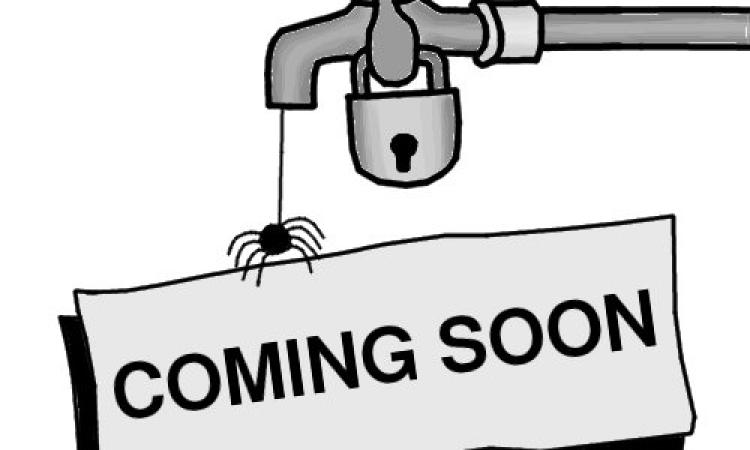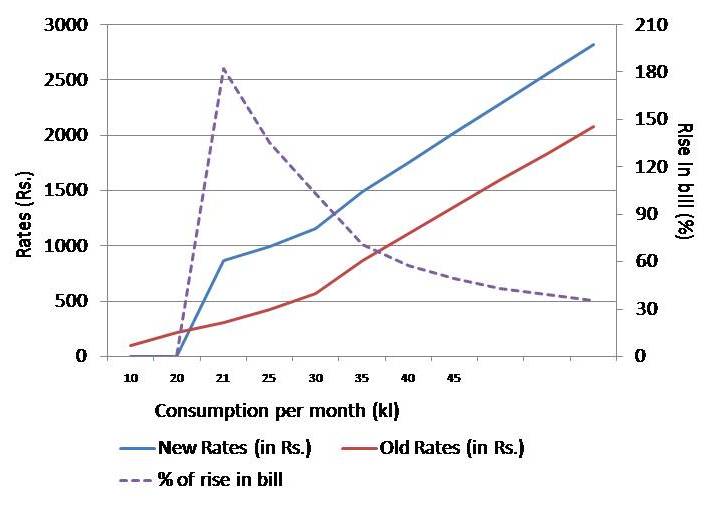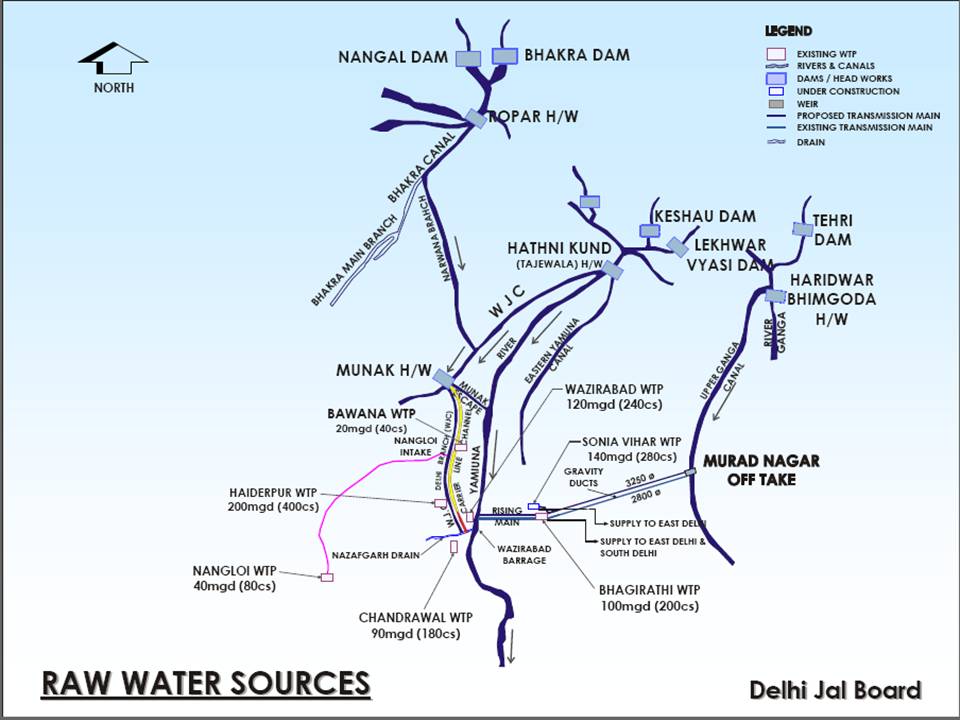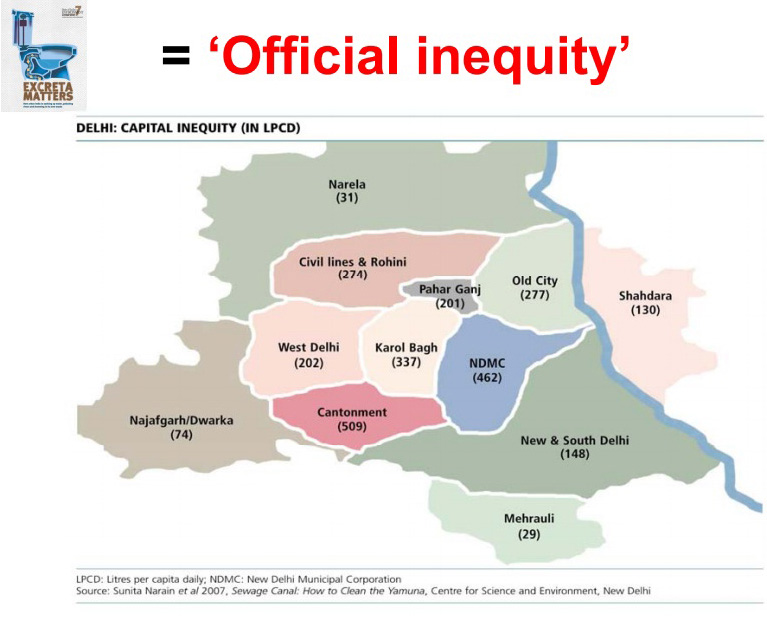
As one of his first orders of business, Delhi's Chief Minister Arvind Kejriwal has announced a new water policy for Delhi-ites. According to this policy, 20 kilolitres (kl) of free water per month will be provided to households with functional water meters from January 1, 2014. This works out to 670 litres free per day, but there is a catch.
A household that uses even 1 litre more than the set limit will have to pay for the entire water consumed in the month as per the new water tariff, which has been hiked by 10% from January 2014. This supply system will continue till March 2014, after which the policy will be evaluated again.
Why 20 kl per month?
The standard set by the Ministry of Urban Development for individual water usage in towns is 135 litres per capita per day (lpcd). The figure of 20 kl was arrived at assuming five people per family (135 X 5 X 30).
How were consumers charged earlier?
There were four slabs depending upon the usage of water per month. The bill included a volumetric charge, a fixed service charge and a sewerage maintenance charge. The table below shows the water tariff for domestic connections under the old and new system.

How is the current tariff plan different from the earlier one?
Consumers who fall in the first 2 slabs, i.e. 0-10 kl and 10-20 kl, incur no charges but if a consumer exceeds the 20 kl per month limit by even 1 litre, they will be liable to pay Rs. 870/- as against Rs. 308/- with respect to the older water tariff system, or an increase of almost 200%. Consumers who fall within the slab of 20-30 kl will be affected the most as they will now be liable to pay their water bills with an increase of 125% on an average.
This graph shows the difference in rates between the two policies:

What are the economic implications of the new policy?
The policy is only applicable to households that have piped water connections and functional meters. This automatically makes 24.8% or six lakh families in the capital non-beneficiaries, as they are not connected to the water grid. This large group continues to depend on water tankers according to the 2013 CAG report, that audited Delhi's water management system.
Tankers supply only 3.82 litres of water per day, against the prescribed norm of 175 lpcd (including the distibution losses of 40%) and charge people anywhere from Rs. 400-500/- per month for this. So at first glance, the new policy does nothing to help these people, the 'real aam aadmi', but let's look at it further.
Due to the high new rates, it is likely that consumers will make more efforts to restrict their usage to fall within the limit of 20 kl. Those consumers who do use water extravagantly, will generate revenue for the Delhi Jal Board (DJB) by paying the higher rates, which are almost equivalent to a fine (in its scale).
Will DJB use these profits towards connecting new people to the water grid?
No, not the way it is right now. It earned a profit of Rs. 446 crore in 2012-13, which is now being spent on the free water policy, rather than connecting more people to the grid.
How does Delhi source and supply its water today?
Delhi receives about 2718 million litres per day (MLD) of raw water from around 10 dams in Haryana, Uttar Pradesh, Rajasthan and Himachal Pradesh (as shown in the map below). Another 378.5 MLD of raw water is derived from groundwater sources that are accounted for in the capital.
Getting water from miles away incurs a production cost of Rs. 28/kl on DJB for its transmission and treatment since the water is in raw form and needs to be treated to make it potable. This includes a cost towards the operation and maintenance of these dams and reservoirs.

The total demand of water for the capital is 3880 MLD, which means that there is already a shortfall of 784 MLD. In addition, groundwater sources in Delhi are fast depleting due to increasing population (8 out of 11 districts in the capital are over exploited). Therefore, the gap in demand and supply is bound to increase further.
The water distribution pattern in Delhi is varied. The map below shows that areas in outer Delhi with unauthorised colonies like Mehrauli and Narela, receive only 29 lpcd and 31 lpcd of water respectively, while posh colonies such as Cantonment and Karol Bagh receive 509 lpcd and 337 lpcd of water, respectively.
A water bill of Rs. 218 for 20 kl of water as per the old tariff is not much for a person from a middle or higher income group who earns more than Rs. 25,000/- per month but for those from the lower income groups, who earn about Rs. 5000/- a month, paying Rs. 400-500/- per month for tanker water supply, whose quality is suspect, is huge.

Is the new policy environmentally sustainable?
Massive wastage of water is expected with the new policy. Dr. R.K. Pachauri, director of The Energy and Resources Institute (TERI), says, "If something is given free, it will never be used efficiently. Instead, give the poor cash transfer subsidy to reduce their burden but give incentives to use water more efficiently".
In addition to this, the DJB has estimated a distribution loss of 40% of the total water supplied due to leakages in the pipeline. Thus, putting more water into the system will mean more water wasted. "If the DJB divert their revenue in plugging of leaks and thereby reduce the distribution loss, then it will help them reduce the gap in demand and supply", says Dhaval D. Desai, from Observer Research Foundation.
What do experts feel about the policy?
Mihir Shah, Head of the Water Working Group - Planning Commission, Government of India, says that “the loss of revenue from freebies to those who are already getting water could push the unconnected even further down the deprivation ladder”.
Himanshu Thakkar from SANDRP, questions the need to give free water to Delhiites when they have the capacity to pay and suggests that "only 50-100 lpcd should have been given free". Bharat Lal Seth, from International Rivers, on the other hand, recommends that "the free water limit for each day should have been set at 200 litres per day".
The scientific basis of the 20 kl per month limit, is also being questioned. "To observe the results of the policy, a better option could have been a pilot demonstration of the policy in key areas of Delhi, instead of implementing the policy straightaway at the city-level", says Kavita Nath, from Arghyam.
How can the AAP government fix Delhi's water problems?
The government can approach this problem two ways. One, it can make modifications to the existing centralised water management system to make it more efficient and effective. Two, it can use a more holistic approach that goes beyond the current paradigm where the government takes responsibility for water supply and distribution. To do the latter, it needs to encourage both Delhi as a whole and its citizens to become self-reliant, through decentralised water management. Some ways it can do this are:
- Implement rainwater harvesting systems strictly: In 2001, the Central Ground Water Authority mandated installation of rainwater harvesting in all institutions and residential colonies in notified areas in Delhi. However, over 90% of rainwater harvesting systems in the capital are either non-functional or have been installed improperly.
- Plug leaks and clamp down on water theft: DJB suffers a distribution loss of 40% due to leaky pipes and water theft. If this problem is addressed, 1860 MLD of the 3097 MLD that Delhi receives, could be saved and used.
- Quieten the water or tanker mafia: Water mafia is a term given to the hundreds of unauthorised water tankers operating in Delhi. Currently, the DJB distributes water through 250 government-owned tankers but it has also outsourced water supply through tankers to three private firms, which has given rise to unauthorised tankers. They extract and supply water from illegal tubewells to consumers at exhorbitant rates of Rs. 700/- per family per month. However, following the AAP's coming to power, the DJB has initiated measures to address the issue by seizing unauthorised tubewells and supplying free water through tankers to unconnected households. Now, the information on schedules, details of tankers and its drivers can be viewed on the DJB's website.
- Institute water audits: The DJB must install bulk meters at its water treatment plants and at each of its 21 water zones that receive raw water to know how much water is entering and exiting the system.
- Install functioning water meters: Statistics show that 75.2% of households in Delhi have metered water connections but their functioning is questionable as they do not work in case of intermittent supply.
- Treat and manage wastewater: According to a recent study by the National Capital Regional Planning Board, 40% of Delhi's population is not connected to the sewerage network despite Delhi having India’s largest installed capacity of Sewage Treatment Plants (STPs). This also implies that STPs in the capital are under-utilised. Delhi has 31 STPs with a combined capacity of 2,475 million litres of sewage per day. However, only 65% of sewage goes into these STPs for treatment while the remaining 35% directly goes into the lakes and rivers. About 3,684 MLD of sewage is discharged into the Yamuna through 18 drains / nallahs. The high levels of pollution have made the river dead as its oxygen level has become too low to support any aquatic life. Treating wastewater will reduce the amount of freshwater needed, as the treated wastewater can be reused for non-drinking domestic and industrial uses. Even if the treated water isn't used, it will at least result in cleaner water, going into the Yamuna and Delhi's lakes and hence pollute them less.
- Revive lakes within the capital: Delhi once had more than 800 big and small ponds / lakes. According to a recent list of water bodies in Delhi by the Parks and Gardens Society, the lakes and baolis are in a deplorable state. These lakes, if revived, will ensure that Delhi isn't short of water and that flooding during monsoons is mitigated. An example is the revived Hauz Khas lake.
The crux of the new policy is water conservation as those who conserve and use water within the specified limits, stand to benefit. The rest will be penalised and pay a high price. This increased revenue from the extravagant 'water spenders' could be potentially used towards connecting more people, the 'real aam aadmi', to the water grid. Maybe that's the motive of the plan but three months may not be enough time to find out.